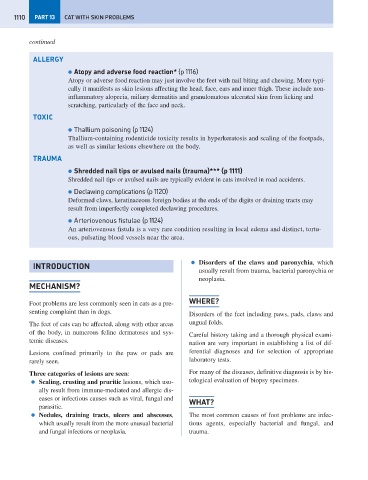Page 1118 - Problem-Based Feline Medicine
P. 1118
1110 PART 13 CAT WITH SKIN PROBLEMS
continued
ALLERGY
● Atopy and adverse food reaction* (p 1116)
Atopy or adverse food reaction may just involve the feet with nail biting and chewing. More typi-
cally it manifests as skin lesions affecting the head, face, ears and inner thigh. These include non-
inflammatory alopecia, miliary dermatitis and granulomatous ulcerated skin from licking and
scratching, particularly of the face and neck.
TOXIC
● Thallium poisoning (p 1124)
Thallium-containing rodenticide toxicity results in hyperkeratosis and scaling of the footpads,
as well as similar lesions elsewhere on the body.
TRAUMA
● Shredded nail tips or avulsed nails (trauma)*** (p 1111)
Shredded nail tips or avulsed nails are typically evident in cats involved in road accidents.
● Declawing complications (p 1120)
Deformed claws, keratinaceous foreign bodies at the ends of the digits or draining tracts may
result from imperfectly completed declawing procedures.
● Arteriovenous fistulae (p 1124)
An arteriovenous fistula is a very rare condition resulting in local edema and distinct, tortu-
ous, pulsating blood vessels near the area.
● Disorders of the claws and paronychia, which
INTRODUCTION
usually result from trauma, bacterial paronychia or
neoplasia.
MECHANISM?
Foot problems are less commonly seen in cats as a pre- WHERE?
senting complaint than in dogs. Disorders of the feet including paws, pads, claws and
The feet of cats can be affected, along with other areas ungual folds.
of the body, in numerous feline dermatoses and sys- Careful history taking and a thorough physical exami-
temic diseases. nation are very important in establishing a list of dif-
Lesions confined primarily to the paw or pads are ferential diagnoses and for selection of appropriate
rarely seen. laboratory tests.
Three categories of lesions are seen: For many of the diseases, definitive diagnosis is by his-
● Scaling, crusting and pruritic lesions, which usu- tological evaluation of biopsy specimens.
ally result from immune-mediated and allergic dis-
eases or infectious causes such as viral, fungal and WHAT?
parasitic.
● Nodules, draining tracts, ulcers and abscesses, The most common causes of foot problems are infec-
which usually result from the more unusual bacterial tious agents, especially bacterial and fungal, and
and fungal infections or neoplasia. trauma.

